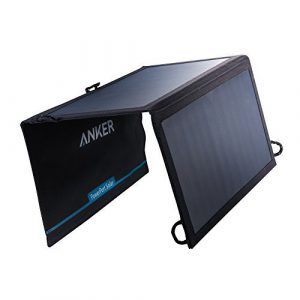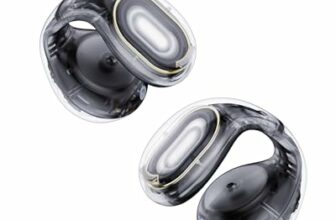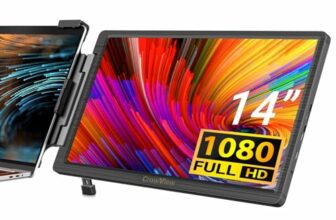Technically Well is supported by our readers. When you purchase an item through links on our site, we may earn an affiliate commission. Read more in our disclosures.
Whether it’s a hurricane, blizzard or even a regular thunderstorm, losing power to your home is not fun. When you lose power, you may be wondering how you’ll stay in contact with loved ones or call for help if you need it. Thankfully, you have a lot of options today for powering your smartphone and staying connected when you need it the most.
Power Banks to the Rescue
A power bank is one of your best choices for staying powered during a storm. As long as your remember to keep it charged, it’s one of your most convenient and effective options.
What to look for
- Capacity: A quick rule of thumb: every 3,000mAh of capacity can recharge your phone about 1 time. So a 10,000mAh power bank can get you about 3 charges, while a 20,000mAh power bank would get you about 6. A tablet requires more power and needs about 10,000mAh per charge.
- Output amperage: Most power banks can output at least 1 amp at 5 volts, usually indicated by something like “5V 1A” on the label. 1 amp is enough to charge your phone. If you plan on charging your tablet, then you’ll want to look for a power bank that can output at least 2 amps.
Some Recommendations
- Large: The Anker PowerCore 26800 can give you up to 9 phone recharges and, if you can get to a power source, the dual inputs allow you to recharge the power bank quickly. Three USB outputs allows multiple people to charge at the same time.
- Medium: The Jackery Titan packs 20100mAh in a durable aluminum shell has enough capacity for about 6 charges to your phone. The two outputs so 2 people can charge their phones at the same time.
- Small: The Anker PowerCore Fusion 5000 can net you up to 2 phone charges, but the main advantage of this charger is the built-in AC charger, allowing you to plug it into a wall when power is available. So you do not need to remember to bring a separate wall charger with this power bank.
Solar Charging Can Help, Too
 If you search for solar power banks on Amazon, you’ll see many external batteries with a small solar cell built-in. Unfortunately, smaller solar cells are not very efficient and it could take several days of bright, sunny weather to completely recharge the power bank.
If you search for solar power banks on Amazon, you’ll see many external batteries with a small solar cell built-in. Unfortunately, smaller solar cells are not very efficient and it could take several days of bright, sunny weather to completely recharge the power bank.
Instead, invest in a larger, dedicated solar USB charger and then use your own power bank to collect the power. Some good options include Anker’s 15W Dual USB Solar Charger as well as AUKEY’s 14W Solar Charger.
Use Your Phone to Stay Informed
Information is power. Be sure to download some weather and news apps to keep you informed during the storm.
- Download Local News Station Apps: Search your phone’s app store for the name of your local news station and you’ll likely find their app and maybe even a dedicated weather app. Be sure to enable push notifications so you can receive breaking news and weather alerts directly on your phone.
- Bookmark Your Local Power Company: If your power utility does not have a dedicated app, bookmark their website in your mobile Safari or Chrome browser app. In particular, look for a dedicated “outage map” page that shows local power outages and the estimated time to restore power. Also be sure to add your local power utility’s phone number to your phone’s contact list so you can report that your power is out!
- Follow Local Resources on Twitter: Create a free Twitter account if you don’t have one and start following your local weather professionals, local official county accounts and your state’s emergency response resources. If you already have an active Twitter account, create a Twitter list so you can focus on the important information and filter out the less urgent tweets.
- Additional App Suggestions: FEMA, The Weather Channel, Emergency: Alerts & Notifications
Preserve the Power You Do Have
- Turn on Low Power Mode. If your phone has a special “battery saver” or “eco” setting, enable it.
- Dim your screen. Go into your phone’s display settings and see if your phone is usable at the lowest setting, even if it means cupping your hand over the screen to see it. The backlight can be one of the biggest drains on your battery.
- Don’t let weather apps drain your battery. If you’re staying put until the storm lets up, consider disabling the GPS (also referred to as “location services”) for your weather apps. Most weather apps will let you enter your zip code in order to retrieve your forecast instead of requiring the use of the GPS.
- Reduce notifications. During an emergency, you probably don’t care that it is your turn in Words With Friends, so disable unnecessary notifications to prevent your screen from lighting up every few seconds. Many phones allow you to change the notifications to “sound only” which helps preserve battery power that would otherwise be used to light up your screen.
- Keep it plugged in. If you haven’t lost power yet, keep your phone plugged into the charger (connected to a surge protector, of course). That way, if your power does go out, your battery will start out at 100%.
Wisely Use Your Devices to Stay Entertained
It’s no fun to sit in the dark watching the weather outside for hours on end. If you have sufficient power available via external batteries, you can download offline movies and TV shows on Netflix and Amazon Prime ahead of the storm to watch during the outage. Also, check with your local library to see if the participate in OverDrive which allows you to download various eBooks and videos for free. You’ll want to download the media while you still have WiFi available. Once the power goes out, your WiFi will go out, too, and you could then incur data overages from your cellular provider if you stream videos using your phone’s data plan.
Please remember to save your primary phone for emergency communications and ensure you have enough power for it to ride out the power outage.









